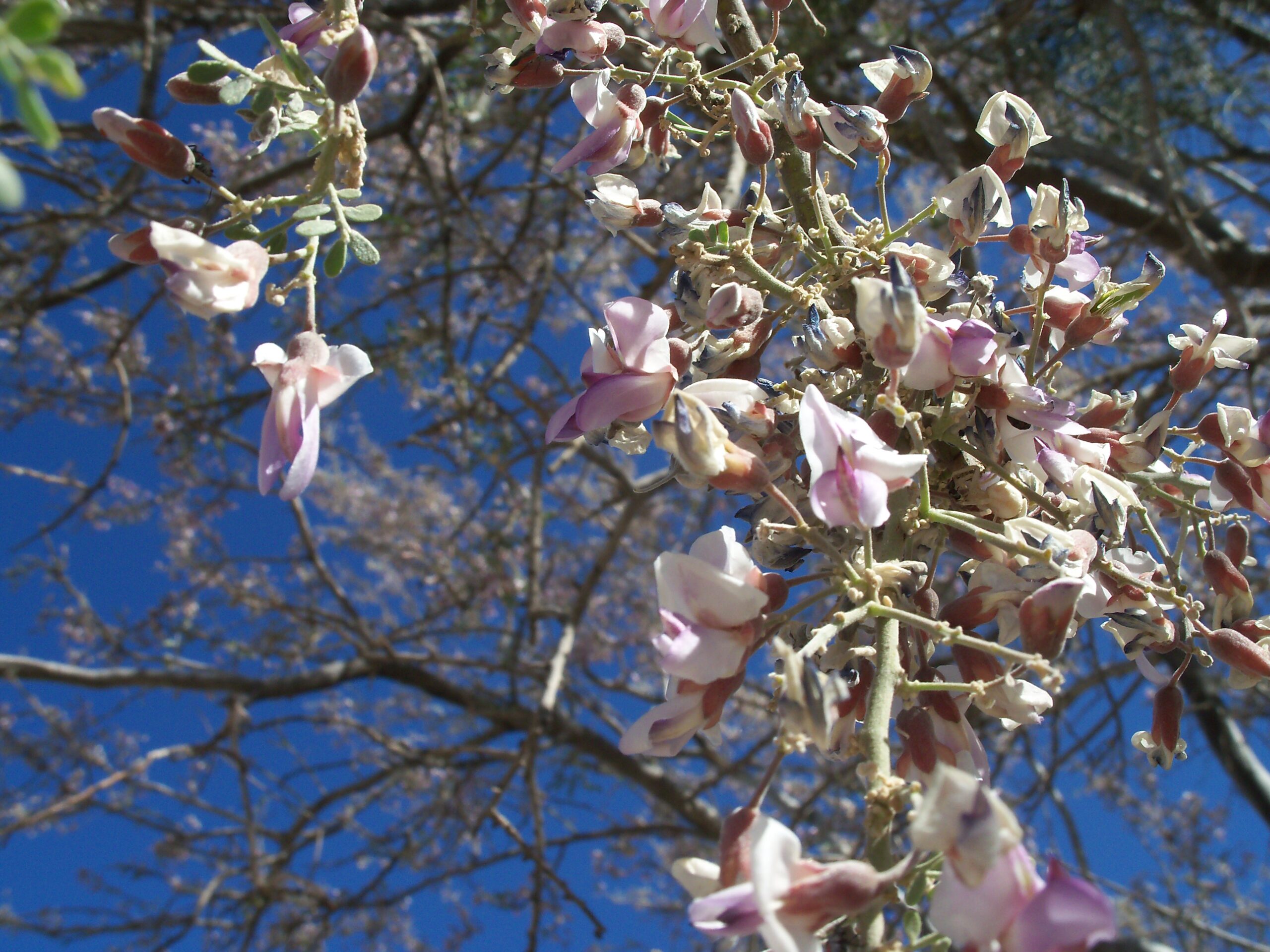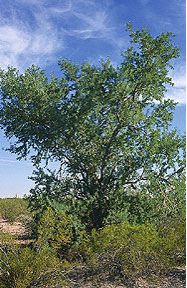Desert Ironwood Tree
The following information is reprinted from the Desert Ironwood Primer: Biodiversity and Uses Associated with Ancient Legume and Cactus Forests in the Sonoran Desert. Originally published in 2000 by the Arizona-Sonora Desert Museum, the Desert Ironwood Primer reports on studies by a bi-national team to conduct a region-wide assessment of desert Ironwood habitat. This report and its recommendations were developed to help guide land use decisions impacting ironwood habitat on both sides of the U.S. / Mexico border. The study was instrumental in the recognition and designation of Ironwood Forest National Monument.
Desert ironwood, or palo fierro in Spanish, provides many wildlife and plants with habitat and resources critical to their survival.
While scientists do not consider ironwood endangered or threatened as a species, its populations are dwindling rapidly and recover extremely slowly after exploitation. Its ecological importance comes largely through the roles it plays for over 500 other species of plants and animals in the Sonoran Desert.

Ironwood ecology
A hardy legume tree, ironwood’s range closely matches the boundaries of the Sonoran Desert, the only place in the world where it occurs. The only species in the genus Olneya, ironwood is notable for its slow growth rates and extremely dense wood. Its wood even sinks in water. While scientists consider ironwood to be the “old growth” tree of the desert, standard tree-ring dating of its wood is difficult. Estimates show some trees to be 800 years old, and it is likely that they live even longer.
Ironwoods bloom profusely in the spring and their blossoms lend a purple hue to the landscape. The pea-type pods mature at a time of year when little else is producing fruit in the Arizona Uplands, leading to a high dependence of wildlife on its seeds. Unlike other desert trees, ironwood rarely sheds all its leaves, so that its canopy provides shade and protection from frost and extreme heat year round.
Ironwood as a Keystone Species and Nurse Plant
Ironwood functions as a habitat modifying keystone species, that is, a species that exhibits strong influences on the distribution and abundance of associated species. Ironwood generates a chain of influences on associated understory plants, affecting their dispersal, germination, establishment, and rates of growth as well as reproduction. Scientists call these ecological dynamics “nurse plant ecology”. Mesquites and palo verde also play this role, however, each tree caters to slightly different sets of plants in its “nursery”. Ironwood is the dominant nurse plant in some subregions of the Sonoran Desert.
As nurse plants, ironwoods provide safe sites for seed dispersal, seedling protection from extreme cold and freezes, and sapling protection from extreme heat and damaging radiation. They also function as prey refugia, providing herbs and cacti protection from herbivores preying on vulnerable plant seedlings. Finally, like other legumes, they alter the soil composition beneath their canopies, enriching the soil with nutrients such as nitrogen.
Ironwood, often the tallest tree in its habitat, attracts birds and other seed dispersers who roost in its branches and generate a literal “rain” of seeds and whole fruit. The mere presence of ironwood and other legume trees can increase the number of bird species in desertscrub habitat by 63%. Germination rates are higher and seedling survival rates better due to the improved soil conditions. Plant health, survival and growth are also improved by the shade and protection from frost that ironwood’s canopy offers. Thorny, low-sweeping branches keep out herbivores, promoting plant growth further. In turn, the greater diversity of plants growing in ironwood nurseries attracts a greater diversity of birds, both breeding and migratory.
The relationship between succulent cacti and ironwoods is especially well documented. Recent studies show that without the protective cover of desert legumes, the distributional ranges of saguaro, organ pipe, and senita cactus would retreat many miles, to more southern, frost-free areas. On freezing nights, the canopies of ironwood, below which the temperature may be 4º C warmer than in adjacent open areas, make the critical difference for vulnerable seedlings.
Ironwood plays a similar role in sheltering seedlings and saplings sensitive to extreme heat and radiation. Its canopy minimizes heat, damaging radiation, and water stress among plants established in its shade. When stripped of ironwood’s protective cover above them, some cacti actually suffer sunburn and die.
In addition to serving as a buffer from such abiotic stresses as soil and moisture conditions, ironwood buffers nursery plants from some biotic stresses, especially that of herbivores. Thorny nurse plants can dramatically reduce the amount of predation on seedlings by large and small herbivores such as cows, rabbits, and rodents. In some places, the high number of animals that nest, burrow or seek refuge under ironwoods reduces this effect.
Ironwood as a Cultural Resource
The many indigenous and ethnic cultures of the Sonoran Desert have long valued ironwood for its cultural, as well as ecological, resources. Traditional products and uses of ironwood include food, medicines, agricultural and household implements, and ceremonial and ritual uses. Because most of these uses utilized either renewable resources (pods, seeds, flowers) or salvaged wood from already dead trees, their impact on ancient ironwood forests was negligible.
The most well known contemporary cultural use of ironwood is by the Seri and Mexican carvers of coastal Sonora. The Seri began to carve elegant, abstract renderings of native animals in the 1960’s. They always use dried, already dead ironwood. Nearby Mexican communities quickly copied the successful forms of the Seri carvings. However, their use of machines allows them to produce carvings at a rate, which is depleting the local supply of ironwood. Attempts to protect the ironwood forests in this area have so far been unsuccessful.
The dense wood of ironwood burns extremely hot, making it the preferred fuelwood in communities in the northern Mexico, where any type of fuelwood is scarce. Mesquite charcoal production for export to the U.S. consumes even more ironwood. Ironwood grows in mixed stands with mesquite and is cut down as an illegal “by-catch” in much the same way tuna nets kill dolphins and other species, though its harvest is usually intentional rather than accidental.
Through the requests of the Seri and others, the Mexican government now requires permits for ironwood cutting, and no permits are given to cut ironwood for charcoal production. However the laws are difficult to enforce, and the incentive to cut dense, heavy ironwood is high among poor woodcutters paid by the weight of wood collected per day.
Threats to Ironwood
In Mexico, woodcutting alone causes an average 17% reduction in ironwood’s dominance in the vegetation of the areas studied. The demand for wood even sends Mexicans over the U.S. border to cut ironwood from Organ Pipe Cactus National Monument and other protected areas. Other impacts threaten ironwood habitat on both sides of the border, especially habitat fragmentation due to the rapid growth of cities such as Tucson, Yuma, Phoenix, Hermosillo and Mexicali, and the conversion of ironwood habitat to agricultural lands.
Grazing and competition by exotic species such as buffelgrass pose additional serious threats to ironwood. Buffelgrass, a popular forage grass for cattle, is highly invasive. Studies show it decreases plant species richness and diversity in native plant communities and increases the frequency of fires. Fueled by buffelgrass, these hot burning wildfires destroy ironwood and other trees and cactus. Among other threats, the population explosion in the Sonoran Desert has led to increasing recreational impacts in ironwood habitat.
Additional and fascinating information about desert ironwood trees can be found on the web site of the Arizona-Sonora Desert Museum as part of the Center for Sonoran Desert Studies.

Ironwood Tree, Olneya tesota
The ironwood tree only grows in the Southwest’s Sonoran Desert. It is one of the biggest and oldest plants, growing to heights of 45 feet and persisting in the desert heat for as long as 1,200 years. Many species of Sonoran wildlife depend on it for survival.
A member of the pea family, the ironwood nurtures hundreds of species of wildlife and is ecologically vital in virtually every corner of the Sonoran Desert. The Ironwood’s presence can increase the number of bird species in a habitat by as much as 63 percent, studies have shown. The heavy canopies of the ironwoods support more than 150 species of birds by providing a shaded sanctuary in an otherwise wide-open landscape. Because of this, the physical environment under the ironwood has lower temperatures and higher water availability. Insects gather under these trees, providing food for birds and reptiles. Cacti that grow under the ironwood make great condos for the birds.
More than 230 plant species have been found starting their growth under an ironwood “nurse plant.” As for other creatures, there are more than 60 reptiles and 64 mammals that use the ironwood for forage, cover and as a place to give birth to their young. Doves, quails, coyotes and small rodents eat the plant’s seeds, which taste similar to peanuts. In one area surrounding Tucson, the ironwood helps support at least 674 plant and animal species.
The ironwood gets its name from its dense, strong iron-like wood. One of the heaviest woods in the world, a mere cubic foot of ironwood can weigh up to 66 pounds. It is so heavy that if you drop a piece of ironwood in water, it will sink.
Single or multi-trunked, the ironwood is considered an evergreen tree despite the fact that its leaves only live one year. The small bluish-green leaves grow in pairs with a pair of spines located beneath each leaf. The leaves remain on the tree until it blooms during May and June. The ironwoods become filled with flowers that range in color from pink to purple to white. When the flowers wither, new leaves grow in and push the old ones off. The ironwood is never really without leaves.
Brown, beanlike seedpods grow after the flowers, each containing 1 to 4 shiny brown seeds. These seeds provide high-protein nourishment for many Sonoran desert creatures as well as humans. Many Indian tribes toast and grind the seeds to make protein-rich flour, or gruel that tastes suspiciously like peanut butter.
Other parts of the plant have been used through the centuries for various things. Native Americans ground the roots into a paste to cure gum infections. They made tea from the crushed leaves to help relieve asthma, and the inner bark was used as an emetic, or agent to induce vomiting. The wood was used for fence posts, charcoal and firewood. They also made tool handles, trinkets and arrowheads out of the hard wood.
Ironwood trees grow in dry locations below 2,500 feet. They are most commonly found along dry washes.
More Information about the desert ironwood tree
- Natural History of the Desert Ironwood Tree
- Historical article about the desert ironwood Tree – “the Tree of Life”, by Gary Paul Nabhan, June 2000. Instrumental in establishing the area as a National Monument.
